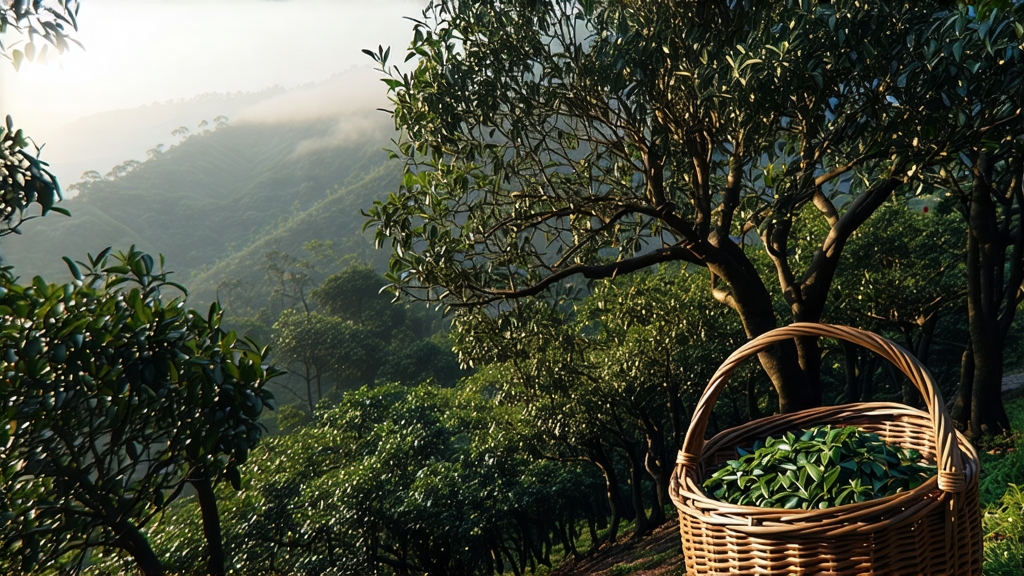
If there were ever a tea that could sing, it would be Phoenix Dancong. Grown on the vertiginous granite slopes of the Wudong massif in northern Guangdong’s Phoenix Mountains, this oolong carries within its twisted, iron-dark leaves the perfume of a whole Chinese valley—magnolia, almond blossom, ripe lychee, mountain honey, and, in the finest lots, an elusive note that locals liken to “ginger flower drifting through hot stone.” To the international drinker accustomed to the broad strokes of Tie Guan Yin or Da Hong Pao, Phoenix Dancong offers a more intimate, almost confidential encounter: every tree can whisper a different scent, and every farmer is a composer working with fire, wind, and memory.
Historical roots
The Song dynasty’s imperial gazetteers already mention “ tribute tea from the Phoenix ridge,” but Dancong’s celebrated individuality began in the Ming, when villagers noticed that certain seed-grown trees produced cups of strikingly different fragrance. Rather than blending them, growers isolated each aromatic type, grafted cuttings, and gave every distinctive tree a poetic name—Tong Tian Xiang (Heaven-Piercing Fragrance), Yu Lan Xiang (Magnolia Fragrance), Mi Lan Xiang (Honey-Orchid), Zhi Lan Xiang (Gardenia), and dozens more. By the late Qing these single-tree lots were so coveted that merchants paid leases on particular trunks years before harvest, a practice that foreshadows today’s micro-lot coffee auctions.
Micro-terroir and cultivar mosaic
Phoenix Mountain is a shattered granite upthrust whose ravines trap cooling mists that slow leaf growth and intensify aromatics. Altitude ranges from 350 m to 1 400 m; the oldest living Dancong, said to be 900 years old, clings to a cliff at 1 100 m. Because the region’s tea population is seed-propagated, every tree is genetically unique; farmers therefore classify not by horticultural cultivar but by xiang xing—“aroma type.” Roughly 80 named fragrances are recognized, grouped into ten floral families. High-elevation teas (termed “high mountain single bush,” or shan ding dancong) fetch the highest prices: cool nights reduce bitter catechins while preserving volatile monoterpenes that translate into cup bouquet.
Plucking choreography
The harvest window is mercilessly short—usually five days between Qingming and Guyu when two-and-a-half leaves and a bud reach “small open face.” Experienced pickers snap the stem with a faint click that signals ideal lignification; the goal is a leaf that is neither too soft (which would bake to flat sweetness) nor too stiff (which resists oxidation). Each ancient tree is climbed with rope and bamboo hoop, a spectacle that draws photographers every spring. A single 300-year-old tree yields at most three kilograms of finished tea, the equivalent of 12 000 cups, hence the nickname “liquid jade.”
Withering: sun, wind, and intuition
Leaves are first spread on cloth-lined bamboo sieves and left in direct morning sun for 20–30 minutes, turned every five minutes to avoid scorch. As cell walls begin to fracture, trays are shifted to the shade of the veranda where mountain breezes continue dehydration. The master monitors turgor loss by pressing a leaf against his forearm; when the edge curls like a shepherd’s crook and the central vein feels pliant yet springy, the leaf is ready for indoor “cooling” on raised racks—an interval that can last from two hours to overnight, depending on humidity. This dual withering phase is critical: too rapid and aromatics remain locked; too slow and grassy volatiles dominate.
Oxidation by vibration: the yao qing ritual
Unique among oolongs, Dancong undergoes “rocking green.” Five kilograms of withered leaves are poured into a 120 cm diameter bamboo drum mounted on a waist-high wooden frame. Two artisans grasp the rim and rotate the drum with a seesaw motion, causing leaves to tumble against each other and the slatted wall. The gentle bruising ruptures 15–20 % of cell tissue, initiating oxidation while preserving leafy integrity. Every five minutes the drum is paused, leaves are fluffed by hand, and aroma is judged. When the fragrance shifts from cut grass to ripe peach skin, rocking stops and the leaf rests for an hour, allowing enzymatic browning to travel inward. The cycle